Are you in the mood for something light, refreshing, and straightforward to make? Say hello to the classic Greek Salad, also known as Horiatiki, the ultimate feel-good dish that proves simple can be seriously satisfying.
Made with just a handful of fresh ingredients, Greek salad is proof that less really is more. It’s a go-to for summer picnics, light lunches, side dishes, or even a hearty meal with just a few tasty add-ins. And the best part? It’s naturally gluten-free, low-carb, and packed with nutrition.
So, whether you’re looking to meal prep your lunches or impress your guests at dinner, this Greek salad recipe is one you’ll want to keep in your back pocket all year long.
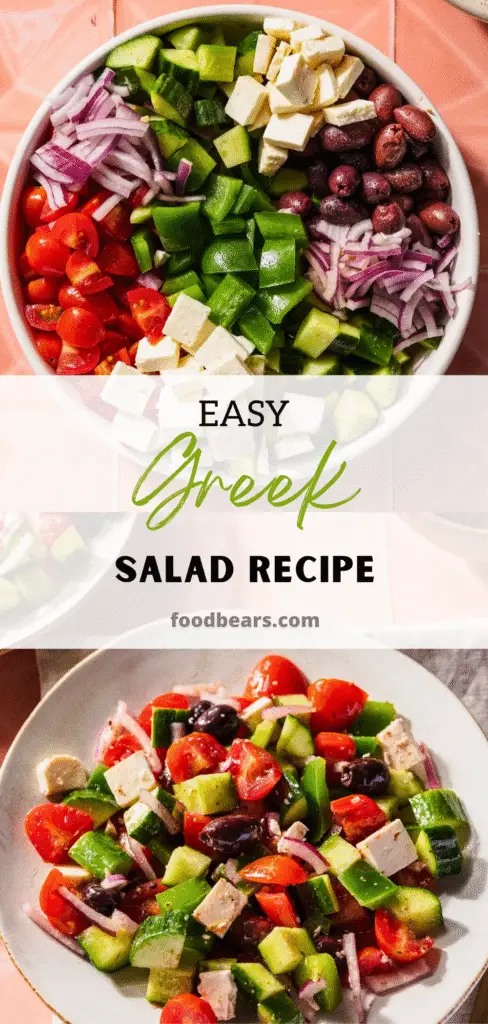
What Is Greek Salad (Horiatiki)?
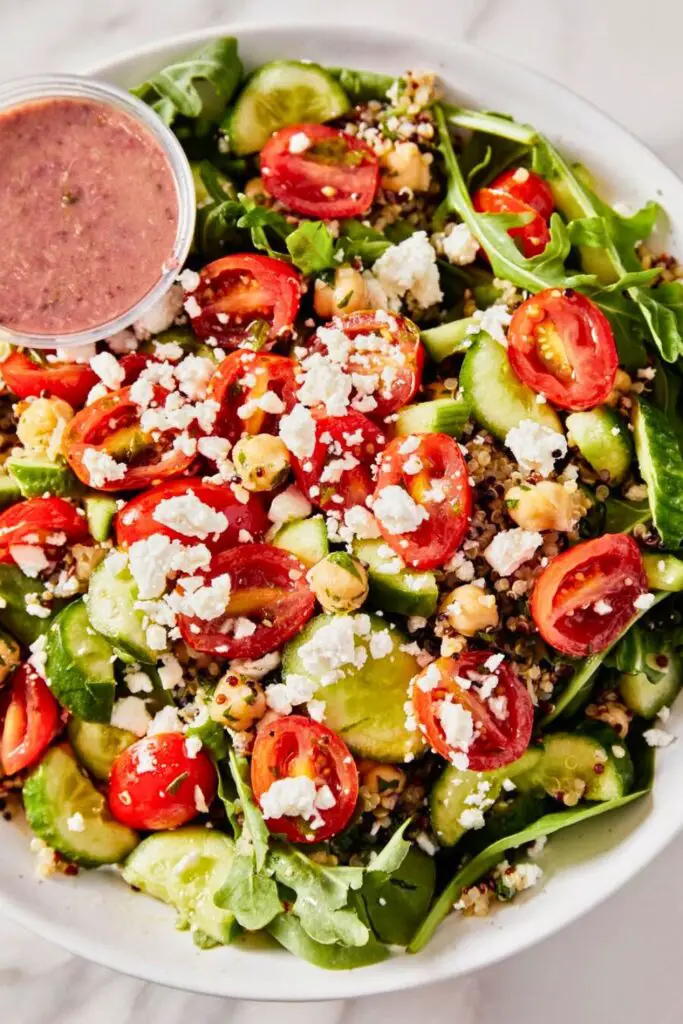
Greek Salad, or Horiatiki (pronounced hor-yah-TEE-kee), is a Mediterranean classic, and here’s why it’s so beloved:
- The word “Horiatiki” means “village salad,” highlighting its rustic and humble roots.
- It’s made with fresh, simple ingredients that local farmers would have on hand.
- No lettuce required, this salad skips the greens and focuses on bold, chunky vegetables.
- You’ll find a vibrant mix of flavors and textures in every bite:
- Juicy tomatoes
- Crunchy cucumbers
- Sweet bell peppers
- Briny Kalamata olives
- Sharp red onion
- Creamy feta cheese
- A zesty vinaigrette or drizzle of olive oil and oregano
- It’s ideal as a side dish or can be turned into a filling main meal by adding proteins.
- Perfect for:
- Warm weather meals
- Light lunches
- Potlucks or parties
- Easy weekly meal prep
- Best part? It’s swift and easy to throw together just a handful of fresh ingredients!
Ingredients: The Magic Six (+1 Dressing)
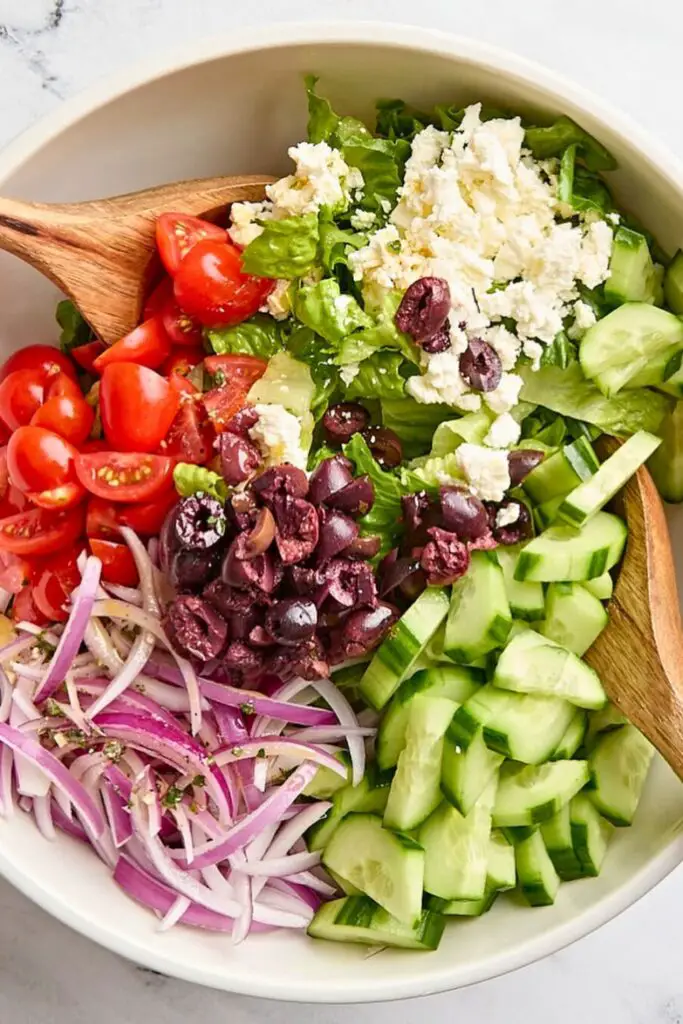
Let’s take a closer look at the six superstar ingredients that make up a traditional Greek salad, plus the essential vinaigrette that brings them all together.
This isn’t the place for a long shopping list. You only need quality produce and a good block of feta to create something truly special.
1. Cucumber: Crisp, Clean, and Hydrating
The base of many great salads, cucumber adds a refreshing crunch. For Greek Salad, English cucumbers are the best choice. They have thin, delicate skin that doesn’t require peeling and fewer seeds than regular cucumbers.
- Why it works: Cucumbers offer a coolness that balances out the bolder ingredients, like onions and olives.
- Tip: Cut them into quarters or large chunks to match the salad’s rustic style.
2. Bell Pepper: A Pop of Color and Sweetness
Bell peppers contribute a subtle sweetness and satisfying crunch. While any color pepper can work, the classic version uses green bell pepper for its slightly grassy taste and traditional look.
- How to prep: Slice off the top and bottom, remove the seeds, and chop into thick strips or chunks.
- No waste hack: Don’t forget the flesh around the stem and ends, they’re edible and delicious!
3. Grape Tomatoes: Juicy and Naturally Sweet
Tomatoes are the juicy soul of the salad. Grape or cherry tomatoes, sliced in half, are ideal for convenience and consistent flavor. If you’re lucky enough to have garden-fresh tomatoes, use them!
- Pro tip: Use the freshest tomatoes you can get. Their sweetness brings balance to the tangy dressing and salty feta.
- Alternative: Large tomatoes work too, chopped into big, rustic chunks.
4. Red Onion: Bold, Sharp, and Slightly Sweet
Red onion is the go-to in Greek salad for a punch of flavor and color. Use half of a medium red onion, sliced top to bottom into thin wedges. This method gives a more elegant appearance and allows the onion to blend better with the other ingredients.
- Why wedges? They look beautiful and add layered texture to the salad.
- Mild it out: If you’re sensitive to strong onions, soak the slices in cold water for 5– 10 minutes before adding them to the salad.
5. Kalamata Olives: A Salty Brine Burst
What would Greek salad be without olives? Kalamata olives, with their dark purple hue and briny bite, are the traditional choice.
- How much? About ½ cup, either sliced in half or left whole, depending on your preference for texture.
- Substitute: If you don’t have Kalamata olives, black or green olives work too, but the flavor won’t be as bold.
6. Feta Cheese: Tangy, Creamy, and Essential
Greek feta is a non-negotiable ingredient in a proper Horiatiki. The best kind? A block of brined Greek feta, not the pre-crumbled tubs you find at the grocery store.
- Why blocks over crumbles? Blocks are creamier, more flavorful, and free from anti-caking agents that dull the taste.
- How to prep: Slice into cubes or hand-crumble into large, rustic pieces.
🧀 Feta tip: Look for feta made from sheep’s milk for an authentic and richer flavor profile.
(+1) The Dressing – Tangy, Zesty, and Homemade
A traditional Greek salad is often drizzled with olive oil and sprinkled with dried oregano. But if you want that restaurant-style flavor with a little more zing, this vinaigrette-style dressing is your secret weapon.
What You’ll Need:
- ⅓ cup red wine vinegar
- Juice of 1 lemon
- 1 tsp Dijon mustard
- 2 garlic cloves, minced
- ½ tsp dried oregano
- ¼ tsp kosher salt
- ¼ tsp black pepper
- ½ cup extra virgin olive oil
How to Make It:
- Add all ingredients except the oil to a bowl.
- Whisk to combine.
- Slowly drizzle in the olive oil while whisking until it emulsifies into a smooth, creamy dressing.
This dressing brings everything together. It’s punchy, garlicky, and a little sharp—the perfect contrast to the creamy feta and mellow veggies.
The Dressing: A Simple Yet Flavorful Vinaigrette
No salad is complete without a killer dressing. And when it comes to Greek salad, the dressing should be just as bold and bright as the vegetables it’s coating.
The beauty of this vinaigrette-style Greek salad dressing lies in its simplicity. It’s quick to make, and you likely already have the ingredients in your pantry.
While traditional Greek salad (Horiatiki) often skips complex dressings and goes for a drizzle of olive oil with a pinch of oregano, this version adds a little zing with vinegar, mustard, lemon, and garlic.
It’s closer to what you’d find bottled at the store, but much fresher and tastier.
Why This Vinaigrette Works So Well
- Red wine vinegar brings that signature Mediterranean tang.
- Lemon juice brightens the flavor and adds a fresh taste.
- Dijon mustard helps the oil and vinegar emulsify, creating a creamy texture.
- Garlic delivers a savory punch.
- Oregano, salt, and pepper balance the acidity and tie everything together.
- Olive oil rounds it all out with smoothness and richness.
Ingredients for the Greek Salad Dressing
Here’s precisely what you’ll need:
- ⅓ cup red wine vinegar
- Juice of 1 fresh lemon (about 2 tablespoons)
- 1 teaspoon Dijon mustard
- 2 garlic cloves, finely minced
- ½ teaspoon dried oregano
- ¼ teaspoon kosher salt
- ¼ teaspoon freshly ground black pepper
- ½ cup extra virgin olive oil
Step-by-Step: How to Make the Dressing
Step 1: Combine the base
In a small mixing bowl or jar, add red wine vinegar, lemon juice, Dijon mustard, garlic, oregano, salt, and pepper.
Step 2: Whisk (or shake) it up
Whisk the ingredients until well combined. If using a jar, close the lid tightly and give it a good shake.
Step 3: Drizzle in the oil
While whisking, slowly drizzle in the olive oil. This gradual addition helps the dressing emulsify, meaning it will hold together rather than separating into layers.
Step 4: Taste and adjust. Please give it a quick taste.
Want it tangier? Add a little more vinegar or lemon. Prefer it more mellow? Add a splash more olive oil.
🫙 Storage Tip: This dressing can be stored in the fridge for up to 1 week. Just give it a shake or whisk before using again.
How to Make Greek Salad: Step-by-Step
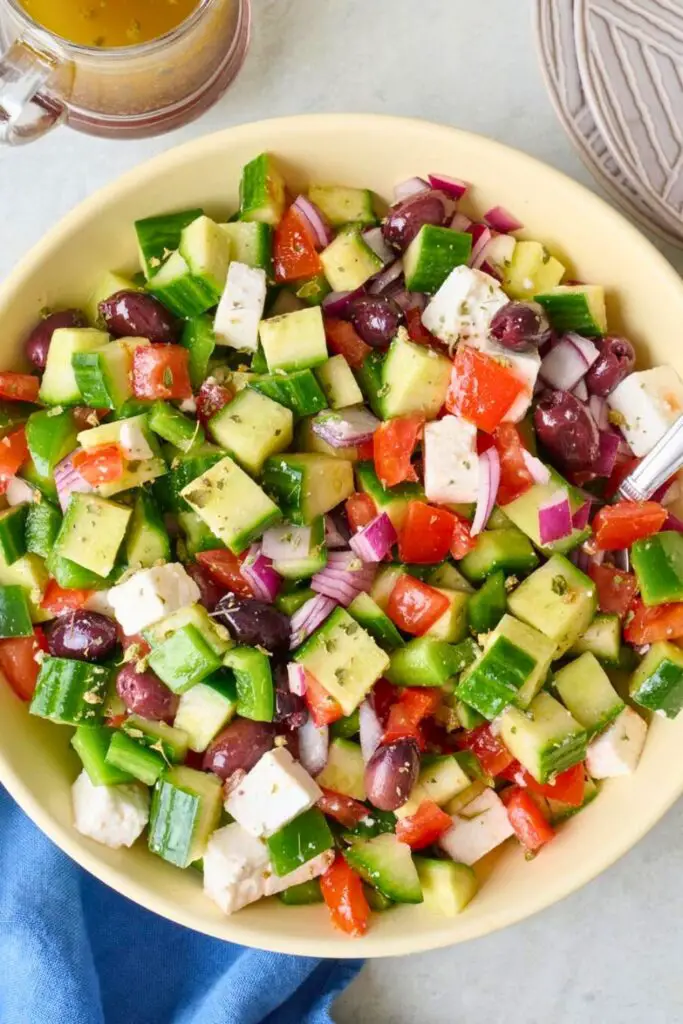
Now that you’ve got the perfect vinaigrette ready, let’s assemble the best Greek salad ever. The key is to keep it rustic. Big pieces, vibrant colors, and minimal fuss.
Step 1: Prep the Veggies
Start with your fresh produce and chop everything, making it ready to go.
Cucumber
- Use 1 large English cucumber
- No need to peel
- Slice it lengthwise, then crosswise into half-moons or quarter chunks
Bell Pepper
- Choose 1 green bell pepper
- Slice off the top and bottom, and remove the seeds
- Cut into strips, then chop into thick pieces
Tomatoes
- Use 1 pint of grape or cherry tomatoes
- Slice each one in half
- Optional: Use large tomatoes cut into wedges if that’s what you have on hand.
Red Onion
- Use ½ a medium red onion
- Slice top to bottom (through the root) into thin wedges
- Gently break apart the layers for even mixing
Kalamata Olives
- Use ½ cup of pitted Kalamata olives
- You can slice them in half or leave them whole for authenticity
Feta Cheese
- Use 4 ounces of block-style Greek feta
- Cut into cubes or crumble into large, rustic chunks by hand
Place all your chopped veggies into a large mixing bowl as you go.
Step 2: Add the Dressing
Pour about half of the vinaigrette over the salad ingredients. Use tongs or a large spoon to toss everything together gently.
- If serving for a party, transfer to a clean serving bowl first for presentation.
- Save the rest of the dressing in a small container or jar to serve on the side.
🎉 Serving Note: Traditional Greek salads are often not tossed. Instead, veggies are layered on a plate and topped with a big slice of feta and a drizzle of oil or dressing.
Step 3: Customize It
You can enjoy this salad exactly as is or turn it into a more filling meal with your favorite proteins.
Here are a few ideas (we’ll explore these more in the next section):
- Add grilled or herb-baked chicken
- Top with canned chickpeas or white beans
- Dice in creamy avocado for healthy fats
Step 4: Chill or Serve Immediately
Greek salad is delicious straight from the bowl, but letting it sit for 10–15 minutes helps the flavors meld even more.
- For meal prep, divide the ingredients into individual containers and store the dressing and toppings separately.
- For parties or family dinners: Toss just before serving and keep extra feta or olives on the side for topping.
Visual Tip: Make It Pretty
To make your salad Pinterest-worthy, try these visual hacks:
- Add a few whole olives or feta cubes on top
- Sprinkle with a pinch of dried oregano before serving
- Drizzle with olive oil for a glossy finish
Why Greek Salad Is Perfect for Meal Prep
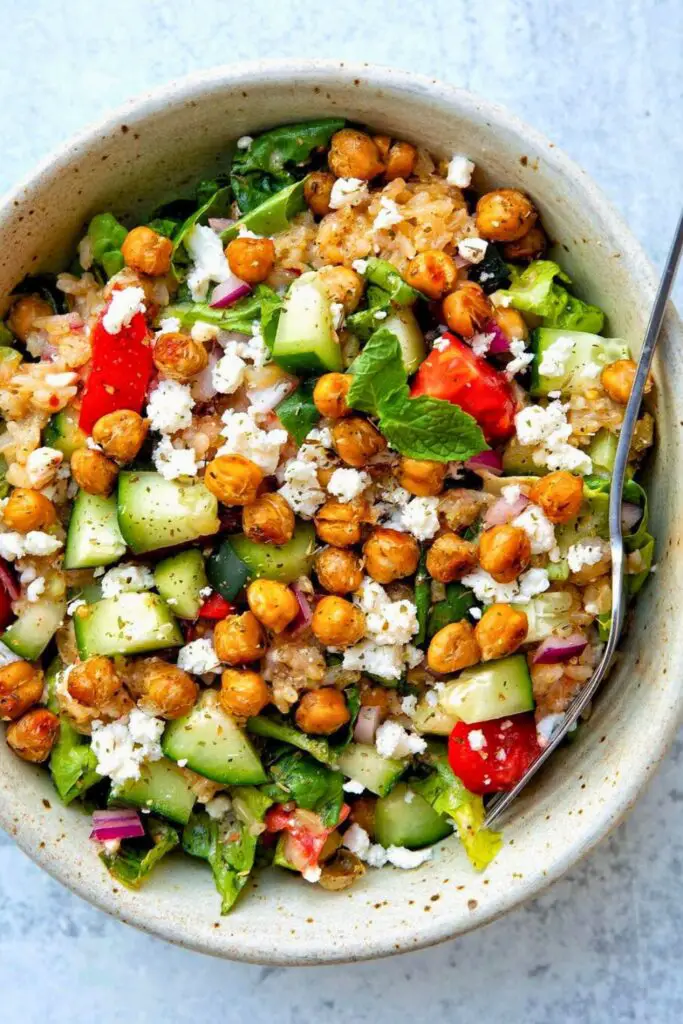
Meal prepping can feel like a chore, but Greek Salad makes it effortless and, dare I say, even enjoyable.
Why? Because it’s one of those rare dishes that gets better after sitting for a bit. The flavors meld, the textures hold up, and nothing turns soggy.
Here’s why Greek salad is a meal prep rockstar:
1. No Lettuce, No Wilting
One of the most significant issues with prepping salads ahead of time is that leafy greens tend to wilt and lose their crunch. Greek Salad doesn’t use any lettuce, so it stays fresh and crisp for days.
2. Chunky Ingredients Stay Intact
Everything in this salad is cut into large, hearty pieces, from the cucumber slices to the cubes of feta. These ingredients don’t break down easily, making them perfect for long-term storage.
3. The Dressing Can Be Stored Separately
Since we’re using a vinaigrette, it stores well in the fridge and doesn’t spoil quickly. Just give it a shake before serving. Keeping the dressing in a separate jar also lets you control how much you use and prevents it from becoming soggy.
4. It’s Easy to Customize in Advance
You can prep all your base ingredients and then mix and match throughout the week:
- Add protein one day (like chicken or beans)
- Swap in an avocado the next
- Serve it as a side one night and a wrap filling the next
5. It Tastes Better with Time
The garlic, herbs, and vinegar in the dressing soak into the veggies just a little more with each day in the fridge. That means your day 3 lunch might taste even better than your day 1 lunch.
How to Turn It Into a Full Meal
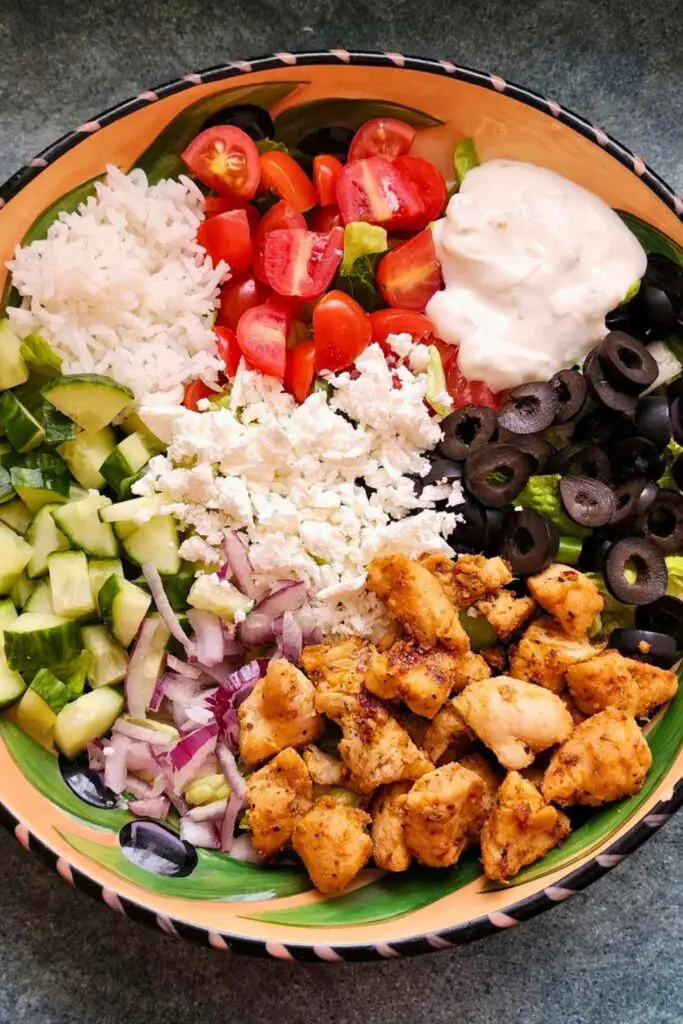
On its own, Greek Salad is a fantastic side dish or light lunch. But if you’re looking for something more filling and satisfying, there are a couple of easy and delicious ways to bulk it up, without losing that light, Mediterranean feel.
1. Add Herb-Baked Chicken
Chicken and Greek salad are a match made in healthy-eating heaven. Here’s how to make an easy herb-baked chicken that pairs beautifully with the salad:
How to Prep It:
- Drizzle chicken breasts with olive oil
- Rub in a mix of dried herbs: basil, thyme, oregano (plus salt and pepper)
- Optional: Add garlic powder for extra punch
- Bake at 425°F (220°C) for 20–25 minutes
- Let it rest, then slice into strips or chunks
Keep it in the fridge and add a portion to your salad for lunch or dinner. It turns a veggie-packed side into a protein-rich main meal that’s great for muscle building and satiety.
2. Add Chickpeas or White Beans
Don’t eat meat? No worries. Chickpeas (also known as garbanzo beans) and white beans make excellent plant-based additions.
- Rinse and drain canned beans well to remove excess starch
- Add ½ cup to your salad for about 7g of protein and plenty of fiber
- Store separately in the fridge and add to individual portions as needed
They absorb the vinaigrette wonderfully and give your salad a creamy texture that complements the crunch of the veggies.
3. Add Avocado
Okay, okay—avocado might not be traditional in a Greek salad, but it’s certainly good. Dicing a quarter of an avocado and adding it to your bowl takes it to the next level.
- Adds healthy fats
- Creates a creamy contrast to the briny feta
- Keeps you feeling full for longer
🥑 Pro tip: Don’t mix in avocado until just before serving to keep it from browning.
4. Serve It With a Grain (Optional Carbs)
Want to turn it into a Mediterranean grain bowl? Add a scoop of:
- Quinoa
- Couscous
- Brown rice
- Farro
You’ll still get all the Greek flavor with an added base that makes it heartier and ideal for athletes, busy professionals, or growing teens.
What Cheese Is Best for Greek Salad?
When it comes to Greek salad, feta cheese is non-negotiable. But not all feta is created equal. For the most authentic taste and texture, here’s what to look for:
1. Block Feta in Brine
The gold standard of feta is Greek block feta stored in brine. This kind is creamy, crumbly, and tangy, with just the right amount of saltiness.
- Why it’s better: Pre-crumbled feta often contains anti-caking agents that dull the flavor and dry out the texture. Block feta, on the other hand, stays moist and rich.
- Pro tip: Buy feta made from sheep’s milk or a mix of sheep and goat milk. It’s more traditional and flavorful than cow’s milk versions.
2. Cut or Crumble by Hand
Don’t fuss over perfect crumbles. In Greek salad, chunky pieces of feta are ideal. You can cut it into cubes, break it up by hand, or even lay a thick slab right on top of the salad, like they do in many Greek tavernas.
🧀 Feta is more than just a topping it’s the salty, creamy contrast that ties the whole dish together.
Final Thoughts
Greek salad isn’t just a side dish; it’s a celebration of simplicity. It’s crisp, colorful, and incredibly customizable, making it one of those go-to recipes you’ll find yourself turning to again and again.
Whether you’re serving it alongside grilled meats, scooping it into a warm pita, or making it your lunch meal prep hero, Greek salad delivers freshness, flavor, and flexibility.
So next time you’re short on time but want something satisfying, healthy, and crowd-pleasing, remember this recipe. It only takes a few ingredients, and the payoff? A bowl of goodness that’s packed with Mediterranean sunshine.
More Fresh Recipes to Try Next
Looking for more healthy and crowd-pleasing ideas? These reader favorites go hand-in-hand with your new Greek salad obsession:
👉 30 Quick Summer Appetizers for Party in 25 Minutes
A mouthwatering roundup of fresh, fast, and fun bites, perfect for your next BBQ, potluck, or dinner party.
👉 Easy Buffalo Cauliflower Bites: A Must-Try in 2025!
Crispy, spicy, and addictive, these are the ultimate healthy snack or party appetizer.
👉 Fresh Corn and Black Bean Salsa Recipe in 15 Mins
Quick, colorful, and bursting with flavor, serve it with chips, tacos, or grilled meats for an easy summer side.

Ella Foster, co-founder of FoodBears.com, is a skilled writer whose love for cooking fuels her creative work. Her passion for experimenting in the kitchen brings authentic flavor and culinary inspiration to every piece she crafts for the platform.
